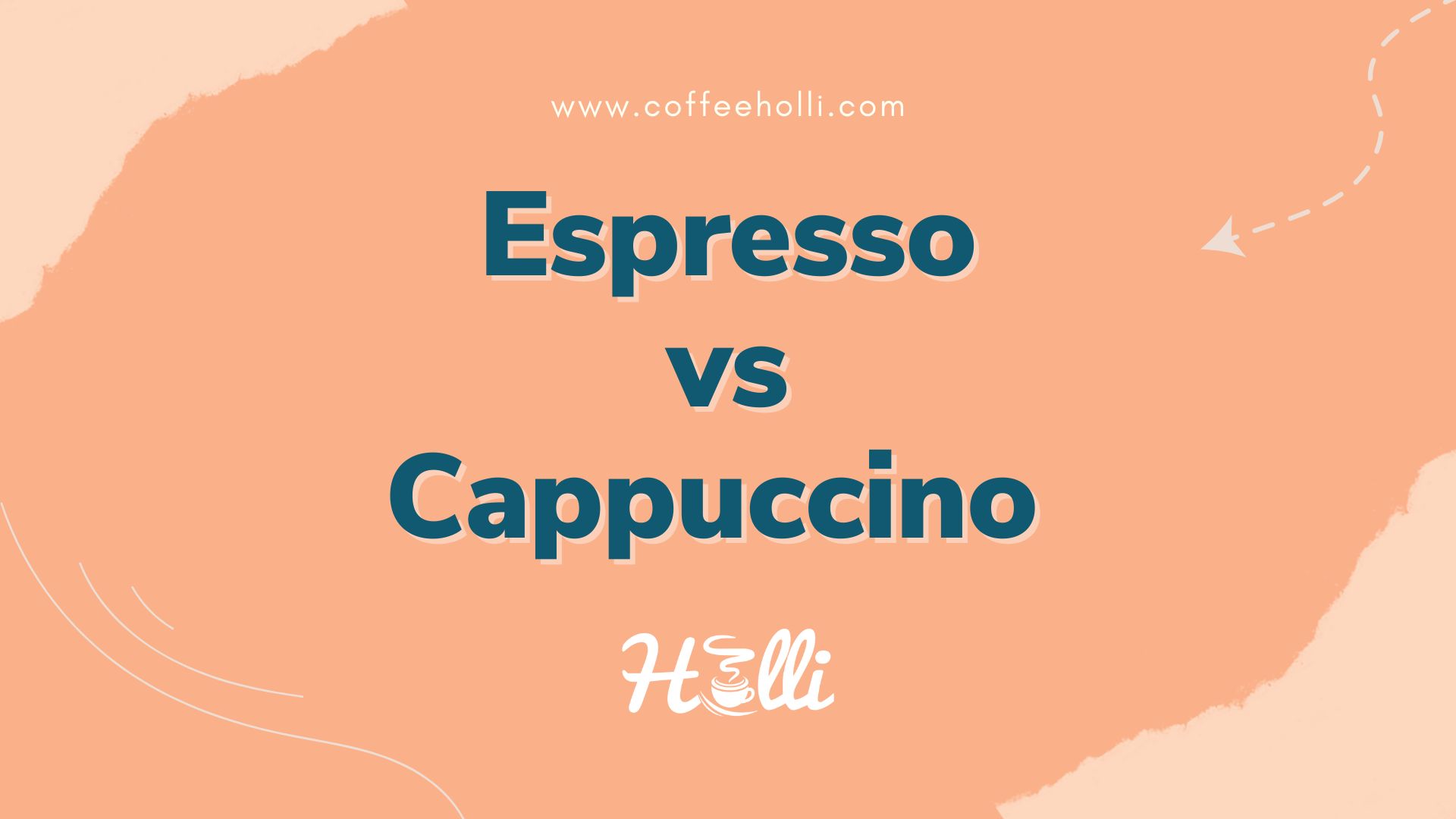
Now:
In 1906 something huge happened that revolutionized how we drink coffee.
Luigi Bezzerra and Desiderio Pavoni unveiled the first espresso machine during the World Fair in Milano.
This gave birth to Espresso coffee and tens of other espresso drinks such as the Capuccino, which is today one of the most popular coffee drinks.
But how does a Cappuccino compare to an Espresso?
That’s what this post is about. We are going to explore and compare these two drinks to help you level up your coffee mastery skills.
With that out of the way, let’s get into today’s business.
Table of Contents
Espresso vs Cappuccino
Espresso is concentrated coffee made by passing hot and pressurized water through roasted and grounded coffee in an Espresso machine. On the other side, a Cappuccino is one of the espresso-based drinks mainly made with 1/3 espresso, 1/3 steamed milk, and 1/3 microfoam.
Now:
While it’s easy to tell an Espresso from a Cappuccino, there are a lot of differences that you cannot point out by just looking at the drinks.
Below is a simple table highlighting the key differences between an Espresso and a Cappuccino.
| Espresso | Cappuccino | |
|---|---|---|
| Origin | Italy | Italy |
| Ingredients | Ground coffee and hot water | 1/3 Espresso, 2/3 steamed milk, and 0.5 cm microfoam |
| Number of shots | 2 shots | 1 or 2 espresso shots |
| Serving size | 2-3 Oz | 8 to 20 Oz |
| Caffeine content | 63-126 mg | 63 – 126 mg |
| Calories | 2-3 | 100-250 |
| Toppings | Sugar Cinnamon | Cinnamon Caramel |
| Taste | Sweet. Acidic. Bitter | Mild espresso flavor. Milky. Sweet |
5 Key Differences Between Espresso vs Cappuccino
1. Origin
Now:
The Espresso drink, which is named after the espresso machine originated in Italy. The word espresso comes from the word esprimere, which translates to press out.
In the case of Espresso, this means, forcing out grounded coffee components. The word espresso means two things.
First, the method of brewing coffee using an espresso machine is called espresso. Then the coffee produced from an espresso machine is also called Espresso.
On the other side:
The Cappuccino also originated in Italy in the 1700s.
While the word Cappuccino had been recorded even before the invention of the espresso machine, the first version of today’s Cappuccino drink came after the invention of the espresso machine in the early 1900s.
2. Ingredients
Now:
There are three widely accepted cappuccino recipes. The most common recipe that you will find online, especially in Barista forums is 1/3 espresso, 1/3 steamed milk, and 1/3 milk foam.
Then there is the Certified Italian Cappuccino by Istituto Nazionale Espresso Italiano. The body defines a Cappuccino as a shot of espresso and 125 ml of steamed cow milk.
Another popular definition is by the World Barista Championship that a Cappuccino comprises 1 shot of espresso and steamed cow’s milk. The drink is less than 240 ml.
On the other side:
An Espresso is made by passing hot and pressurized water through roasted and ground coffee.
One shot of espresso (25-30 ml) is made using 7-8 grams of ground coffee, while a double shot (50-60 ml) is prepared with 14-16 grams of ground coffee.
Unlike other brewing methods that take longer, the espresso brewing method is very speedy. It takes about 25 seconds to pull one or double-shot espresso.
Espresso drink alternatives include the ristretto and lungo. While all of them use the same amount of ground coffee, lungo has the biggest yield, and ristretto has the smallest yield.
3. Serving
Now:
An Espresso is traditionally a 1 or 2-ounce drink served in a Demitasse cup, which is the traditional espresso cup.
Despite a shot or double shot of espresso being a small drink, it is not supposed to be a single-sip drink. Drink it sip by sip to experience and enjoy its full glory.
On the other side:
A Cappuccino is traditionally a 5-6 Oz serving. However, some coffee shops such as Starbucks serve large servings of between 8 Oz to 16 Oz.
A Cappuccino is served in a Cappuccino cup.
See our other comparison of Cappuccino vs Macchiato.
4. Taste
Here is the thing:
A bare espresso shot is for the chosen few. The drink is concentrated and intense. Those who find it harsh, opt to dilute it with milk or water.
There are also others who say Espresso makes them poop or gassy.
When it comes to taste, Espresso’s taste components (sweet, bitter, and acidic) should fit and complement each other.
Ultimately the quality of the espresso is determined by the beans. A cup made with high-quality and perfectly roasted beans will be magical.
While a shot of espresso made with poor-quality beans will be horrible and can only be salvaged by adding lots of milk
On the other side
A Cappuccino has a strong espresso taste and is a little bit sweet. The milk and foam should balance the bitterness and acidity of the espresso resulting in incredible flavors and texture.
5. Nutritional value
Now:
A double shot of espresso has about 126 caffeine and 4 calories.
On the flip side, an 8-ounce Cappuccino serving containing 2 shots of espresso has 126 mg of caffeine and 70 calories.
Conclusion
Here is a recap of how an espresso compares to a Cappuccino
- Espresso is concentrated coffee made by passing pressurized hot water through ground coffee.
- A Cappuccino is made with espresso, steamed milk, and microfoam.
- A Cappuccino has more calories than an espresso
- While espresso is concentrated and intense, a Cappuccino is a little bit sweet.
- Espresso is a 2-3 ounce drink while a cappuccino is a 5-6 ounce drink
- While espresso has crema on top, Cappuccino has microfoam
And that is it for Espresso vs Cappuccino. Was this guide helpful? If you’d like to contribute or if you have a question, leave it in the comment section below.
Frequently Asked Questions
A single shot and double shot of espresso contain 63 mg and 126 mg of caffeine, respectively according to the USDA.
Any Cappuccino serving prepared with 1 and 2 shots of espresso has 63 and 126 mg of caffeine respectively.
No, an Espresso is way stronger than a Cappuccino. Espresso is bare with no milk or water added, while a Cappuccino is diluted with steamed milk and microfoam.
None is better than the other one. It’s all about preference. There are people who enjoy all these drinks.
Espresso is for those who can handle the intensity, Cappuccino is when you want a balanced espresso and milk flavors and a Latte is for when you want a comforting milky drink with a mild espresso flavor.
Espresso has no milk or water added. On the other hand, a Cappuccino is an espresso-based drink prepared with 1 or shots of espresso, steamed milk, and microfoam.
A Cappuccino is either 1 or 2 shots. Both the World Barista Championship and Istituto Nazionale Espresso Italiano Cappuccino versions are made with 1 shot of espresso.


